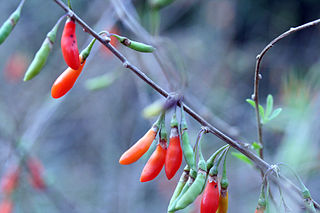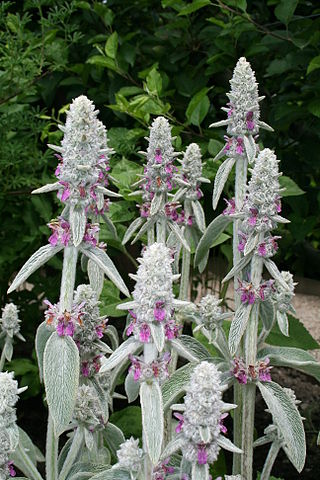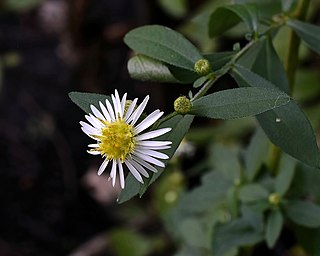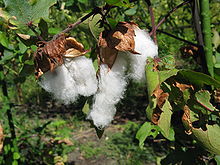
Gossypium is a genus of flowering plants in the tribe Gossypieae of the mallow family, Malvaceae, from which cotton is harvested. It is native to tropical and subtropical regions of the Old and New Worlds. There are about 50 Gossypium species, making it the largest genus in the tribe Gossypieae, and new species continue to be discovered. The name of the genus is derived from the Arabic word goz, which refers to a soft substance.

Lycium chinense is one of two species of boxthorn shrub in the family Solanaceae. Along with Lycium barbarum, it produces the goji berry ("wolfberry"). Two varieties are recognized, L. chinense var. chinense and L. chinense var. potaninii. It is also known as Chinese boxthorn, Chinese matrimony-vine, Chinese teaplant, Chinese wolfberry, wolfberry, and Chinese desert-thorn.

Campanula latifolia, the giant bellflower, is a species of bellflower in the family Campanulaceae. It is also known as the large campanula and the wide-leaved bellflower. It is native to Europe and western Asia and is widely grown as an ornamental plant.

Codiaeum variegatum is a species of plant in the genus Codiaeum, which is a member of the family Euphorbiaceae. It was described by Carl Linnaeus in 1753. It is native to Indonesia, Malaysia, Australia, and the western Pacific Ocean islands, growing in open forests and scrub.

Aeonium arboreum, the tree aeonium, tree houseleek, or Irish rose, is a succulent, subtropical subshrub in the flowering plant family Crassulaceae.

Stachys byzantina, the lamb's-ear or woolly hedgenettle, is a species of flowering plant in the mint family Lamiaceae, native to Armenia, Iran, and Turkey. It is cultivated throughout much of the temperate world as an ornamental plant, and is naturalised in some locations as an escapee from gardens. Plants are very often found under the synonym Stachys lanata or Stachys olympica.

Echinacea atrorubens, called the Topeka purple coneflower, is a North American species of flowering plant in the family Asteraceae. It is native to eastern Kansas, Oklahoma, and eastern Texas in the south-central United States. It is found growing in dry soils around limestone or sandstone outcroppings and prairies.

Cephalotaxus fortunei, commonly called the Chinese plum-yew, Fortune's yew plum, simply plum yew, Chinese cowtail pine or in Chinese as san jian shan, is a coniferous shrub or small tree in the family Taxaceae. It is native to northern Burma and China, but is sometimes grown in western gardens where it has been in cultivation since 1848.

Eurybia divaricata, the white wood aster, is an herbaceous plant native to eastern North America. It occurs in the eastern United States, primarily in the Appalachian Mountains, though it is also present in southeastern Canada, but only in about 25 populations in the provinces of Ontario and Quebec. In the U.S. it is abundant and common, but in Canada it is considered threatened due to its restricted distribution. It has been introduced to a number of countries in Europe. It can be found in dry open woods as well as along wood-edges and clearings. The species is distinguished by its flower heads that have yellow centers and white rays that are arranged in flat-topped corymbiform arrays, emerging in the late summer through fall. Other distinguishing characteristics include its serpentine stems and sharply serrated narrow heart-shaped leaves. The white wood aster is sometimes used in cultivation in both North America and Europe due to it being quite tough and for its showy flowers.

Eurybia is a genus of plants in the family Asteraceae that were previously included in the genus Aster. Most species are native to North America, although one is also present in northern Eurasia. There are 23 species in the genus, including 1 natural hybrid. The name was first applied by Alexandre de Cassini in 1820. The name is derived from Ancient Greek εὐρύς (eurús), meaning "wide", and βαιός (baiós), meaning "few", perhaps in reference to the small number of relatively wide ray florets.

Grevillea acanthifolia, commonly known as the Acanthus-leaved grevillea, is a plant in the family Proteaceae and is endemic to New South Wales. It is a shrub with stiff, prickly, divided leaves and pink to purple "toothbrush" flowers.
Schoepfia harrisii is a species of flowering plant in the Schoepfiaceae family. It is a small tree or shrub, growing two to five metres tall. It is endemic to Jamaica, where it is only known to occur in the parishes of Trelawny and Clarendon, in what is known as Cockpit Country, a region of many steep, rounded, limestone hills, shaped like an egg-carton. Here it grows on crags in moist woodland, between 600 and 900m in elevation.

Brunfelsia pauciflora is a species of flowering plant in the family Solanaceae, the nightshades. It is endemic to Brazil, and it is grown in cultivation. A shrubby perennial plant grown in gardens, its common names include today, tomorrow together, yesterday, today and tomorrow, morning-noon-and-night, kiss me quick, and Brazil raintree.

Deutzia gracilis, the slender deutzia or Japanese snow flower, is a species of flowering plant in the hydrangea family Hydrangeaceae, native to Japan.

Brugmansia arborea, the angel's trumpet, is a species of flowering plant in the family Solanaceae. The IUCN has classed Brugmansia arborea as Extinct in the Wild.

Brunfelsia latifolia, commonly known as yesterday-today-tomorrow and kiss me quick, is a species of flowering plant in the nightshade family. Endemic to Brazil, it is an evergreen shrub that becomes semi-deciduous in cooler areas and grows up to 1.8 meters in height.
Philadelphus mexicanus is a shrub belonging to the genus Philadelphus, native to Mexico and Guatemala. It is a spreading, evergreen shrub with pendent, bristly shoots and ovate, sometimes partly toothed leaves up to 11 centimetres (4.3 in) long. Flowers are single, cup shaped, rose scented, creamy white in colour, measuring up to 4 centimetres (1.6 in) across. 'Rose syringa' is the most commonly cultivated variety and has fragrant white flowers with a purple blotch in the centre.

Muslin, a Phuti carpus cotton fabric of plain weave, was historically hand woven in the areas of Dhaka and Sonargaon in Bangladesh and exported for many centuries. The region forms the eastern part of the historic region of Bengal. The muslin trade at one time made the Ganges delta and what is now Bangladesh into one of the most prosperous parts of the world. Of all the unique elements that must come together to manufacture muslin, none is as unique as the cotton, the famous "phuti karpas", scientifically known as Gossypium arboreum var. neglecta. Dhaka muslin was immensely popular and sold across the globe for millennia. Muslin from "India" is mentioned in the book Periplus of the Erythraean Sea, authored by an anonymous Egyptian merchant around 2,000 years ago, it was appreciated by the Ancient Greeks and Romans, and the fabled fabric was the pinnacle of European fashion in the 18th and 19th century. Production ceased sometime in the late 19th century, as the Bengali muslin industry could no longer compete against cheaper British-made textiles.

Symphyotrichum ontarionis is a species of flowering plant in the family Asteraceae native to eastern North America. Commonly known as Ontario aster and bottomland aster, it is a perennial, herbaceous plant that may reach heights of 120 centimeters. Each flower head has many tiny florets put together into what appear as one.
Plectranthus purpuratus or cliff spurflower is a species of flowering plant in the family Lamiaceae, native to South Africa's Kwazulu-Natal and Mpumalanga provinces, as well as eSwatini. The name is frequently misapplied to Plectranthus ciliatus, presumably because both have purple-backed leaves.


















